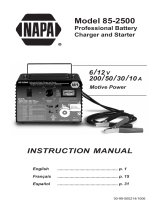
2
1. Make sure you have a 12 or 24 volt lead-acid battery. Check
car owner manual to make sure.
2. Clean battery terminals. Take care to keep corrosion from
coming in contact with your eyes.
3. If required, add distilled water in each cell until battery acid
reaches levels specified by battery manufacturer. This helps
purge excessive gas from cells. Do not overfill. For a battery
without cell caps, carefully follow manufacturer's recharging
instructions.
4. Study all battery manufacturer's specific precautions, such
as removing or not removing cell caps while charging, and
recommended rates of charge.
5. Be sure area around battery is well ventilated while battery
is being charged. Gas can be forcefully blown away by using
a piece of cardboard or other non-metallic material as a fan.
6. If necessary to remove battery from vehicle to charge, always
remove grounded terminal from battery first. Make sure all
accessories in the vehicle are off, so as not to cause an arc.
7. A marine (boat) battery must be removed and charged on
shore. To charge it on board requires equipment specially
designed for marine use.
GROUNDING AND AC POWER CORD CONNECTION INSTRUC-
TIONS - Charger should be grounded to reduce risk of electric
shock. Charger is equipped with an electric cord having an equip-
ment-grounding conductor and a grounding plug. The plug must
be plugged into an outlet that is properly installed and grounded
in accordance with local codes and ordinances.
DANGER - Never alter AC cord or plug provided - if it will not fit
outlet, have proper outlet installed by a qualified electrician. Im-
proper connection can result in a risk of electric shock.
This battery charger is for use on a nominal 120-volt circuit, and
has a grounding plug that looks like the plug illustrated in sketch
A. A temporary adapter, which looks like the adapter illustrated in
sketch B, may be used to connect this plug to a two-pole recep-
tacle as shown in sketch B if a properly grounded outlet is not
available. The temporary adapter should be used only until a
properly grounded outlet can be installed by a qualified electri-
cian.
During operation do not place the charger or its cables on the
vehicle seat or carpeting.
1. WARNING: Wear complete eye protection and clothing
protection, when working with lead-acid batteries.
2. Make sure someone is within range of your voice or close
enough to come to your aid when you work with or near a
lead-acid battery.
3. Have plenty of fresh water and soap nearby for use if battery
acid contacts skin, clothing, or eyes. If battery acid contacts
skin or clothing, wash immediately with soap and water.
4. Avoid touching your eyes while working with a battery. Acid
particles (corrosion) may get into your eyes! If acid enters
your eye, immediately flood eye with running cold water for
at least 10 minutes. Get medical attention immediately.
5. Remove all personal metal items such as rings, bracelets,
necklaces, and watches when working with a lead-acid
battery. A lead-acid battery can produce a short-circuit current
high enough to weld a ring (or the like) to metal, causing a
severe burn.
6. Take care not to drop a metal tool or other metal onto the
battery. Metal may cause sparking or short circuit the battery
or another electrical devise. Sparking may cause an
explosion.
7. Always operate battery charger in an open well ventilated
area.
8. NEVER smoke or allow a spark or flame in the vicinity of the
battery or engine. Batteries generate explosive gases!
FIGURE 1: GROUNDING METHODS
C. PREPARING TO CHARGE
B. PERSONAL PRECAUTIONS AND SAFETY
When charging a battery in a RV or motor home always connect
one lead of the output cable to the battery. Never connect to a
remote receptacle or other means for the purpose of remotely
charging the battery. The wires may be inadequate for handling
the charge current of this charger and may over heat. Often these
wires are bundled in with other wires which could be damaged
and lead to a direct short across the battery and charger. If this
occurs a fire can result, equipment and appliances operated
from the battery may also be damaged.
DANGER - Before using adapter as illustrated, be certain that
center screw of outlet plate is grounded. The green-colored rigid
ear or lug extending from adapter must be connected to a prop-
erly grounded outlet - make certain it is grounded. If necessary,
replace original outlet cover plate screw with a longer screw that
will secure adapter ear or lug to outlet cover plate and make
ground connection to grounded outlet.
Use of an adapter plug is not allowed in Canada.
GROUNDED OUTLET
GROUNDING PIN
(A)
(B)
ADAPTER
METAL SCREW
COVER
OF GROUNDED
OUTLET BOX






